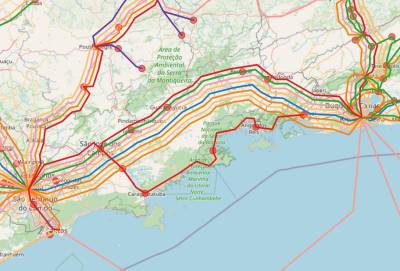This is an old revision of the document!
Table of Contents
Terrestrial Fibre Optic Infrastructure
What is the Open Fibre Data Standard?
The Open Fibre Data Standard or OFDS is an open data, open standards initiative. Put simply it is a standardised way of describing terrestrial fibre optic networks designed to enable effective information sharing and aggregation among telecommunication regulators and operators.
OFDS builds on the tradition of and lessons learned from important transparency initiatives such as Open Corporates and the International Aid Transparency Initiative.
Why Is Transparency for Terrestrial Fibre Optic Networks Essential?
Understanding the true extent, resiliency, and redundancy of fibre investments
 Fibre optic networks are the foundation of the modern internet. They are “deep water ports”, offering orders of magnitude of greater communication capacity than any other access technology. They are the digital trade routes of the 21st century. Understanding the range, extent, and resiliency of fibre optic infrastructure, particularly at the junctions where fibre networks overlap or connect with each other is essential to forming a holistic picture of evolving internet infrastructure.
Fibre optic networks are the foundation of the modern internet. They are “deep water ports”, offering orders of magnitude of greater communication capacity than any other access technology. They are the digital trade routes of the 21st century. Understanding the range, extent, and resiliency of fibre optic infrastructure, particularly at the junctions where fibre networks overlap or connect with each other is essential to forming a holistic picture of evolving internet infrastructure.
Without a common standard for describing fibre infrastructure, it is easy to miscalculate or misunderstand its extent. For example, Liquid Intelligent Technologies operate one of the largest fibre optic networks on the continent with fibre spanning from Cape Town to Cairo. Yet their network infrastructure in Tanzania, circled on the map to the left is not physically theirs but is represents long-term broadband capacity they have leased from the Tanzanian government’s National ICT Broadband Backbone (NICTBB). Someone looking at the NICTBB and Liquid’s maps might conclude that this represented two backbone networks in the country.
 On busy routes, the issue is compounded. Looking at the map to the right which represents composite data on fibre networks collected by the Brazilian regulator. It appears that there are nine fibre networks connecting São Paulo and Rio de Janeiro but the reality is much more likely that there are 3 or 4 operators with other operators purchasing capacity or dark fibre from the actual cable owners. Without a common standard for describing fibre networks, this becomes a very challenging question to answer; a question which has implications for understanding the overall resiliency of national network infrastructure. When it comes to fibre optic networks, resiliency lies in the ability of a network to fail gracefully, seamlessly shifting traffic on to other networks. Understanding the interplay of heterogeneous fibre networks is key to understanding resiliency.
On busy routes, the issue is compounded. Looking at the map to the right which represents composite data on fibre networks collected by the Brazilian regulator. It appears that there are nine fibre networks connecting São Paulo and Rio de Janeiro but the reality is much more likely that there are 3 or 4 operators with other operators purchasing capacity or dark fibre from the actual cable owners. Without a common standard for describing fibre networks, this becomes a very challenging question to answer; a question which has implications for understanding the overall resiliency of national network infrastructure. When it comes to fibre optic networks, resiliency lies in the ability of a network to fail gracefully, seamlessly shifting traffic on to other networks. Understanding the interplay of heterogeneous fibre networks is key to understanding resiliency.
Understanding the impact of fibre optic investments
Around the world, billions of dollars have been invested in terrestrial fibre optic networks. Yet there is a dearth of available research on the impact of these investments. This is due, in large part, to the lack of readily available data on fibre network investment and deployments. An exception to this is the open data resource on African terrestrial fibre optic networks (AfTerFibre) maintained by the Network Startup Resource Center. In 2019, researchers were able to use the AfTerFibre open data resource to demonstrate a positive correlation between proximity to fibre optic networks and employment levels.
This represents the tip of the iceberg when it comes to insights that might be derived from more comprehensive and accurate information on terrestrial fibre networks. New potential areas for investigation include research into:
- Impact of climate change on network infrastructure;
- Cost effectiveness of various fibre network build-out methodologies and technologies;
- Overall network resiliency and redundancy
- Impact of cross-border connectivity investments
But fibre networks come in all sorts of shapes and sizes, from underground to aerial, from a few fibre strands to hundreds, from old technology to new.
